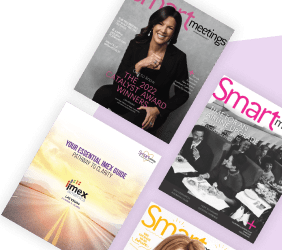The trade show floor is buzzing. Attendees saunter from one activation to another, ice skating at one booth, building a Lego block persona at another. The temporary world in an expo hall represents hundreds of thousands of dollars of investment on the part of the organizer and the sponsors. But is it working?
The same question can be asked of investments in big name general session keynotes and breakout sessions.
Nick Borelli, marketing director of Zenus.ai, a company specializing in ethical AI facial analysis, attended Smart Meetings Innovation Experience in Atlantic City. He walked attendees through an exercise where they planned an entire event for the nonprofit SEARCH Foundation in a few short hours using AI and explained that the answer to the ultimate return on event questions are rooted in data, not guesswork.
From Cool Gimmick to Strategic Essential
Zenus has worked with PCMA’s Convening Leaders conference for three years, evolving from simple operational insights (“Were sessions full?”) to more subtle suggestions about how to improve stickiness at booths and reporting on how people felt about a $30,000 speaker. “It quickly became clear that data could tell a much deeper story than just counting heads,” he said.
Read More: Rebranded PCMA Embraced World Stage
With over-the-top activations like “rooftop lounges” and indoor ice skating rinks, PCMA isn’t your average trade show. But therein lies the problem. “It’s chaos,” Borelli says. “There’s no standard grid of 10×10 booths. You have apples and oranges all over the place.”
Zenus solves this by applying facial analysis from dozens of strategically placed cameras to measure key metrics: dwell time, sentiment, engagement and foot traffic. The tech can quantify what was once purely anecdotal: Was the activation compelling? Did it resonate? And crucially, how did it compare to others?
For the first time ever at PCMA Convening Leaders 2025, Zenus analysts provided real-time coaching to top sponsors based on day-one data. “Usually we talk about ‘next year,’ but this time it was ‘tomorrow,’” says Borelli. “They adjusted staff positions, changed signage and reconfigured space.”
The insights went beyond impressions. “We looked at when dwell time turned into disengagement. If you’re talking to someone for seven minutes and their sentiment starts to dip, it might be time to wrap it up.”
Quality vs. Quantity
Borelli emphasizes that success isn’t always about the biggest crowd. “Some brands benefited from adding friction,” he says. “Think of a wooden fence around a Western-themed booth. Not everyone enters, but those who do are more qualified.”
He compares this to gated content in digital marketing. “You filter for serious interest. And that’s gold for B2B brands investing six figures in a booth.”
Zenus’s team noted that booth design played a big role in success. Barriers like fences or elevated platforms could either invite or repel engagement. The placement of staff, the openness of the space and even the positioning of giveaways all had measurable impact.
Data-Driven Storytelling

One of the most compelling outcomes? Exhibitors left with actual data to justify ROI. “A new CFO at a major toy company challenged their Comic-Con presence, asking, ‘Why are we here?’” Borelli recalls. “Now, with facial analysis, they can show how many people engaged, what they felt and how long they stayed.”
Read More: Top 10 Meeting Cities for Geeks
Even macro-level insights emerged. For example:
- Day 1: Higher impressions, lower engagement.
- Day 2: Fewer attendees, but more meaningful conversations.
“That tells exhibitors when to focus their energy,” Borelli says. “Day one might be for grabbing attention; Day two is when deals happen.”
What Makes It Ethical?
The concern many initially have about whether watching the movements of attendees is borderline creepy or outright wrong is based on a misunderstanding of what the technology does.
“We never identify anyone,” Borelli explains. “This is aggregate data only—no facial recognition, no stored personal information. That’s where the ethical line is drawn. We care about what people feel in the moment, not who they are.”
Read More: What is AI Good For Anyway?
The sensors simply read expressions and behaviors anonymously with data records, not photos, offering real-time emotional insights and interactions. This lets exhibitors make immediate, informed changes.
“Facial analysis can sound creepy,” Borelli acknowledges, “but when it’s done right, it’s simply a new form of feedback. And we’re not just measuring what happened—we’re helping to make what happens next even better.”
A Culture of Curiosity
Perhaps the biggest takeaway is the shift in mindset. “PCMA deserves credit for being open to this kind of feedback,” says Borelli. “Most organizers don’t want to hear what didn’t work. But growth comes from curiosity, not defensiveness.”
In fact, he believes this approach should be baked into the culture of events moving forward. “Post-show surveys are too little, too late. Real-time feedback creates real-time learning.”
What Borelli ultimately hopes to change is the binary thinking that dominates event success metrics. “It’s not just about leads vs. no leads. It’s about qualified conversations, emotional engagement and intentional design. We want the industry to ask better questions.”





